Life Cycle Assessment of a Rotationally Asymmetrical Compound Parabolic Concentrator (RACPC)
Abstract
1. Introduction
“Life Cycle Assessment (LCA) is a technique for assessing the potential environmental aspects and potential aspects associated with a product (or service), by: compiling an inventory of relevant inputs and outputs, evaluating the potential environmental impacts associated with those inputs and outputs, and interpreting the results of the inventory and impact phases in relation to the objectives of the study”.
2. Components of the Analysis
2.1. Energy Pay Back Time (EPBT)
- Ein is the total input for: material, modules and additional components’ manufacture; system installation; material disposal; transportation.
- Emat is the energy demand for material manufacturing (materials of: modules and system additional components) and module manufacture.
- Eins is the energy needed for the installation of the system.
- Edisp is the energy requirement for transportation of the materials/components from building to the disposal site.
- Etransp is the energy required to transport the materials/components from the factory gate to the building.
- Eout.a is the annual yield of the solar PV system converted into primary energy. This would require the information of grid efficiency, i.e., the life cycle energy conversion efficiency (ηG) of the country-specific energy-mixture used for electricity generation and for producing the materials.
- EO&M.a is the annual energy requirement during the use/operational phase of the system.
2.2. Energy Return on Investment (EROI)
2.3. Assumptions
- The systems operation and maintenance impact (EO&M.a) accounts for the replacement and maintenance of one glass cover, one replacement of a module, general maintenance and cleaning.
- Employing the required grid efficiency of 0.31 into the of EPBT assessment [37].
- Values for Eout.a have been experimentally measured [19]; therefore the Performance Ratio (PR) can be neglected.
3. Life Cycle Assessment
3.1. Cost Assessment
3.1.1. PV Material
- Conventional PV module with a size of 0.94 m2 requires 48 solar cells. Consequently, the total cost of PV material is GBP 26.88.
- RACPC-PV module with dimensions of 111 cm × 85 cm requires 1850 solar cells, each being 1 cm2. Moreover, as mentioned in Abu-Bakar [19], it was possible to arrange custom-made solar cells to required dimensions, with prices for each cell being proportional to the PV material used. As a result, there is a 24.7% reduction in PV material. The calculated cost of PV material to produce an RACPC-PV module adds up to GBP 6.64 per module.
3.1.2. Concentrator
- A single RACPC-PV module requires a proportional number of concentrators to the number of PV cells; therefore, 1850 concentrators are required, each weighing at around 7.94 g [19]. As a result, the assessed total price for concentrators is GBP 8.67 per module.
- Unlike RACPC-PV, the Conventional PV does not use any form of concentrators; therefore, price is not applicable.
3.1.3. Glass
- Conventional PV requires 2 layers of substrate to cover the back and the front of the module. Assuming that the front and rear of the PV utilizes the same glass cover, the assessed cost per bulk adds up to GBP 5.80 per module.
- Unlike the conventional PV, RACPC-PV requires only one layer of the glass cover; therefore, the total cost is GBP 2.90 per module, which is a half of the conventional PV.
3.1.4. Encapsulation
- Conventional PV module requires two layers of Ethylene Vinyl Acetate (EVA) lamination film. From research, an average cost of a 4-mm-thick EVA film is at around GBP 1.22/m2 [45], as a result, the total cost of EVA laminated film is GBP 2.30 per module.
3.1.5. Frame
- Due to the assumption that RACPC-PV and conventional PV modules are both built to 0.94 m2, the price spent on the construction of the frame for RACPC-PV module will be the exact same as for a conventional PV.
3.1.6. Wiring
- RACPC-PV module requires 83.84 m to connect all the solar cells together [19]. The required tabbing wire size of 1 mm × 0.1 mm was calculated to cost GBP 0.58 per module.
3.2. Embodied Energy Assessment
3.2.1. PV Material
- RACPC-PV: Due to the 24.7% reduction in PV materials, the embodied energy is reduced to 518 MJ/m2.
3.2.2. Concentrator
- Conventional PV does not use any form of concentrators; therefore, the impact is not applicable.
- RACPC-PV utilises PMMA as the material used for concentrators, with an assessed embodied energy coefficient of 93.8 MJ/kg [55], resulting in the embodied energy of all 1850 concentrators to be 1377.5 MJ.
3.2.3. Glass
- RACPC-PV utilises only one layer of glass, and it was found to be a half of the conventional glass, being 160 MJ for a single layer of glass.
3.2.4. Encapsulation
3.2.5. Frame
- RACPC-PV is utilising the exact same material for the frame and requires the exact same length for the 0.94 m2 module. As a result, the embodied energy is the same as the conventional PV of 452.04 MJ.
3.2.6. Wiring
- One RACPC-PV module requires 83.84 m of 1 mm × 0.1 mm tabbing wire [19]; as a result, the calculated embodied energy is 5.09 MJ.
3.3. Impact Assessment
4. Conclusions
- Cost Assessment has revealed the cost for a module to cost; GBP 39.66 for conventional PV and GBP 28.12 for RACPC-PV, presenting a 29.09% cost reduction. The previously established cost assessment by Abu Bakar et al. [18] presented the cost for a module to cost; GBP 44.09 for conventional PV and GBP 30.09 for RACPC-PV, with a proposed cost reduction of 31.75%. The established differences in cost reductions was linked with the constantly declining cost of PV material.
- The embodied energy calculations of a squared meter module presented an 11.76% reduction, favouring RACPC-PV as the more economic module, resulting in a decreased amount of energy required for the manufacture of module materials. Despite a great decrease utilization of PV material in RACPC-PV modules, the substantially high embodied energy coefficient of concentrating material (PMMA) resulted in lower embodied energy reduction.
- The impact assessment evaluated both modules’ EPBT and EROI. The EPBT calculations revealed: 8.01 years for a conventional PV module and 6.63 years for RACPC-PV module. Furthermore, EROI calculations revealed the conventional PV module to have a ratio of 3.12, and a ratio of 3.77 for RACPC-PV module.
Author Contributions
Funding
Conflicts of Interest
References
- EPA Global Greenhouse Gas Emissions Data. Available online: https://www.epa.gov/ghgemissions/global-greenhouse-gas-emissions-data (accessed on 26 March 2018).
- Spry, W.; Lucking, B. Section 6-UK Renewables; Department for Business, Energy & Industrial Strategy: London, UK, 2019. [Google Scholar]
- Fan, J. Life Cycle Assessment and Life Cycle Cost of Phootovoltaic Panels on Lake Street Parking Garage; Colorado State University: Fort Collins, CO, USA, 2014. [Google Scholar]
- Shukla, A.K.; Sudhakar, K.; Baredar, P. Exergetic analysis of building integrated semitransparent photovoltaic module in clear sky condition at Bhopal India. Case Stud. Therm. Eng. 2016, 8, 142–151. [Google Scholar] [CrossRef]
- Dunbar, R. How Efficient Will Solar PV Be in the Future? 10-Year Predictions for the Industry. Available online: https://cleantechnica.com/2017/08/15/efficient-will-solar-pv-future-10-year-predictions-industry/ (accessed on 30 March 2018).
- Green Rhino Energy Ltd. Concentrating Photovoltaics (CPV). Available online: http://www.greenrhinoenergy.com/solar/technologies/pv_concentration.php (accessed on 30 March 2018).
- Norton, B.; Eames, P.C.; Mallick, T.K.; Huang, M.J.; McCormack, S.J.; Mondol, J.D.; Yohanis, Y.G. Enhancing the performance of building integrated photovoltaics. Sol. Energy 2011, 85, 1629–1664. [Google Scholar] [CrossRef]
- Baig, H.; Mallick, T.K. Challenges and opportunities in concentrating photovoltaic research. Mod. Energy Rev. 2011, 3, 18–26. [Google Scholar]
- Sellami, N.; Mallick, T.K.; McNeil, D.A. Optical characterisation of 3-D static solar concentrator. Energy Convers. Manag. 2012, 64, 579–586. [Google Scholar] [CrossRef]
- Muhammad-Sukki, F.; Abu-Bakar, S.H.; Ramirez-Iniguez, R.; McMeekin, S.G.; Stewart, B.G.; Sarmah, N.; Mallick, T.K.; Munir, A.B.; Mohd Yasin, S.H.; Abdul Rahim, R. Mirror symmetrical dielectric totally internally reflecting concentrator for building integrated photovoltaic systems. Appl. Energy 2014, 113, 32–40. [Google Scholar] [CrossRef]
- Muhammad-Sukki, F.; Ramirez-iniguez, R.; Mcmeekin, S.G.; Stewart, B.G.; Clive, B. Solar concentrators. Int. J. Appl. Sci. 2010, 1, 1–15. [Google Scholar]
- Zacharopoulos, A.; Eames, P.; McLarnon, D.; Norton, B. Linear dielectric non-imaging concentrating covers for PV integrated building facades. Sol. Energy 2000, 68, 439–452. [Google Scholar] [CrossRef]
- Mallick, T.K.; Eames, P.C.; Hyde, T.J.; Norton, B. The design and experimental characterisation of an asymmetric compound parabolic photovoltaic concentrator for building façade integration in the UK. Sol. Energy 2004, 77, 319–327. [Google Scholar] [CrossRef]
- Mallick, T.K.; Eames, P.C. Design and fabrication of low concentrating second generation PRIDE concentrator. Sol. Energy Mater. Sol. Cells 2007, 91, 597–608. [Google Scholar] [CrossRef]
- Sarmah, N.; Mallick, T.K. Design, fabrication and outdoor performance analysis of a low concentrating photovoltaic system. Sol. Energy 2015, 112, 361–372. [Google Scholar] [CrossRef]
- Abu-Bakar, S.H.; Muhammad-Sukki, F.; Ramirez-Iniguez, R.; Mallick, T.K.; Munir, A.B.; Mohd Yasin, S.H.; Abdul Rahim, R. Rotationally asymmetrical compound parabolic concentrator for concentrating photovoltaic applications. Appl. Energy 2014, 136, 363–372. [Google Scholar] [CrossRef]
- Abu-Bakar, S.H.; Muhammad-Sukki, F.; Freier, D.; Ramirez-Iniguez, R.; Mallick, T.K.; Munir, A.B.; Mohd Yasin, S.H.; Abubakar Mas’ud, A.; Md Yunus, N. Performance analysis of a novel rotationally asymmetrical compound parabolic concentrator. Appl. Energy 2015, 154, 221–231. [Google Scholar] [CrossRef]
- Abu-Bakar, S.H.; Muhammad-Sukki, F.; Freier, D.; Ramirez-Iniguez, R.; Mallick, T.K.; Munir, A.B.; Mohd Yasin, S.H.; Abubakar Mas’ud, A.; Abu-Bakar, S.S.; Bani, N.A.; et al. Potential of implementing the low concentration photovoltaic systems in the United Kingdom. Int. J. Electr. Comput. Eng. 2017, 7, 1398–1405. [Google Scholar] [CrossRef][Green Version]
- Abu-Bakar, S.H. Novel Rotationally Asymmetrical Solar Concentrator for the buBlding Integrated Photovoltaic System; Glasgow Caledonian University: Glasgow, UK, 2016. [Google Scholar]
- Tian, M.; Su, Y.; Zheng, H.; Pei, G.; Li, G.; Riffat, S. A review on the recent research progress in the compound parabolic concentrator (CPC) for solar energy applications. Renew. Sustain. Energy Rev. 2018, 82, 1272–1296. [Google Scholar] [CrossRef]
- Shanks, K.; Senthilarasu, S.; Mallick, T.K. Optics for concentrating photovoltaics: Trends, limits and opportunities for materials and design. Renew. Sustain. Energy Rev. 2016, 60, 394–407. [Google Scholar] [CrossRef]
- Madala, S.; Boehm, R.F. A review of nonimaging solar concentrators for stationary and passive tracking applications. Renew. Sustain. Energy Rev. 2017, 71, 309–322. [Google Scholar] [CrossRef]
- Freier, D.; Ramirez-Iniguez, R.; Jafry, T.; Muhammad-Sukki, F.; Gamio, C. A review of optical concentrators for portable solar photovoltaic systems for developing countries. Renew. Sustain. Energy Rev. 2018, 90, 957–968. [Google Scholar] [CrossRef]
- Sarmah, N.; Richards, B.S.; Mallick, T.K. Design, development and indoor performance analysis of a low concentrating dielectric photovoltaic module. Sol. Energy 2014, 103, 390–401. [Google Scholar] [CrossRef]
- Lamnatou, C.; Baig, H.; Chemisana, D.; Mallick, T.K. Life cycle energy analysis and embodied carbon of a linear dielectric-based concentrating photovoltaic appropriate for building-integrated applications. Energy Build. 2015, 107, 366–375. [Google Scholar] [CrossRef]
- Srinivas, H. Life Cycle Assessment. Available online: http://www.gdrc.org/uem/lca/lca-define.html (accessed on 24 April 2020).
- International Organization for Standardization. ISO 14040:2006—Environmental Management—Life Cycle Assessment—Principles and Framework; International Organization for Standardization: Paris, France, 2006; pp. 1–20. [Google Scholar]
- XE. Available online: https://www.xe.com/currencyconverter/ (accessed on 30 March 2018).
- ENF. Solar Panel Directory. Available online: https://www.enfsolar.com/ (accessed on 30 March 2018).
- ECO Expert. Kyocera. Available online: http://directory.theecoexperts.co.uk/manufacturer/kyocera (accessed on 17 May 2015).
- Solar Capture Technologies. Cells. Available online: http://solarcapturetechnologies.com/services/manufacturing/cells (accessed on 2 November 2014).
- Abu-Bakar, S.H.; Muhammad-Sukki, F.; Freier, D.; Ramirez-Iniguez, R.; Mallick, T.K.; Munir, A.B.; Mohd Yasin, S.H.; Abubakar Mas’ud, A.; Md Yunus, N. Optimisation of the performance of a novel rotationally asymmetrical optical concentrator design for building integrated photovoltaic system. Energy 2015, 90, 1033–1045. [Google Scholar] [CrossRef]
- ExpertSure. 4kw Solar Systems: The Best Set Up For Less Than £7000? Available online: https://www.expertsure.com/uk/home/4kw-solar-systems/ (accessed on 30 March 2018).
- IEA-PVPS EPTP EPIA. Compared Assessment of Selected Environmental Indicators of Photovoltaic Electricity in OECD Cities. 2006. Available online: https://unef.es/wp-content/uploads/dlm_uploads/2016/11/compared-assessment-of-selected-environmental-indicators-of-photovoltaic-electricity-in-oecd-cities-2.pdf (accessed on 30 March 2018).
- Lamnatou, C.; Notton, G.; Chemisana, D.; Cristofari, C. The environmental performance of a building-integrated solar thermal collector, based on multiple approaches and life-cycle impact assessment methodologies. Build. Environ. 2015, 87, 45–58. [Google Scholar] [CrossRef]
- Lamnatou, C.; Notton, G.; Chemisana, D.; Cristofari, C. Life cycle analysis of a building-integrated solar thermal collector, based on embodied energy and embodied carbon methodologies. Energy Build. 2014, 84, 378–387. [Google Scholar] [CrossRef]
- Reinders, A.; Verlinden, P.; van Sark, W.; Freundlich, A. Photovoltaic Solar Energy: From Fundamentals to Applications, 1st ed.; John Wiley & Sons Ltd.: West Sussex, UK, 2017; ISBN 9781118927465. [Google Scholar]
- The ECO Experts. 4 kW Solar Systems—4 Tips to Decide If One Is Right for You. Available online: https://www.theecoexperts.co.uk/solar-panels/4kw-pv-systems (accessed on 28 March 2018).
- Menoufi, K.; Chemisana, D.; Rosell, J.I. Life cycle assessment of a building integrated concentrated photovoltaic scheme. Appl. Energy 2013, 111, 505–514. [Google Scholar] [CrossRef]
- Curran, M.A. Strengths and Limitations of Life Cycle Assessment. In Background and Future Prospects in Life Cycle Assessment; Klöpffer, W., Ed.; Springer: Dordrecht, Germany, 2014; pp. 189–206. [Google Scholar]
- Hammond, G.P.; Harajli, H.A.; Jones, C.I.; Winnett, A.B. Whole systems appraisal of a UK Building Integrated Photovoltaic (BIPV) system: Energy, environmental, and economic evaluations. Energy Policy 2012, 40, 219–230. [Google Scholar] [CrossRef]
- 17.9%~19.0% 125*125mm Mono Solar Cells 5 × 5 Grade A Monocrystalline Silicon PV Wafer For Diy Home Photovoltaic Solar Panels. Available online: https://www.alibaba.com/product-detail/17-9-19-0-125-125mm_60754740062.html?spm=a2700.7724857.main07.57.18e43b46PRkSor (accessed on 26 March 2018).
- Plasticker Raw Materials & Prices. Available online: http://plasticker.de/preise/pms_en.php (accessed on 26 March 2018).
- 3.2 mm 4 mm Transparent Solar Panel Clear Solar Panel. Available online: https://www.alibaba.com/product-detail/3-2mm-4mm-Transparent-Solar-Panel_1659883472.html?spm=a2700.7724857.29.1.ouGfoX&s=p. (accessed on 26 March 2018).
- SP-EVA-300 PV Solar Back Sheet eva Film for Laminated Glass Film. Available online: https://www.alibaba.com/product-detail/SP-EVA-300-pv-solar-back_2022768153.html?spm=a2700.7724838.2017115.11.3f59f8bbisA5aI. (accessed on 28 March 2018).
- Silicone Elastomer Kit, Silicone Gel, Silicone Rubber for Molding. Available online: https://www.alibaba.com/product-detail/silicone-elastomer-kit-silicone-gel-silicone_737520138.html (accessed on 28 March 2018).
- Skov, A.L.; Hvilsted, S.; Mazurek, P.S. Silicone Elastomers and Their Preparation and Use. W.O. Patent 2016189117A1, 1 December 2016. [Google Scholar]
- High Performance Aluminum Solar Panel Frame. Available online: https://www.alibaba.com/product-detail/High-Performance-Aluminum-Solar-Panel-Frame_557763975.html?spm=a2700.7724838.35.1.bB4hKI. (accessed on 26 March 2018).
- Custom Thickness Bus Wire for Solar Photovoltaic Ribbon. Available online: https://www.alibaba.com/product-detail/Custom-Thickness-Bus-Wire-For-Solar_60715496311.html?spm=a2700.7724838.2017115.25.8316b1yTV5YO. (accessed on 26 March 2018).
- Darby, M. Solar Panel Costs Predicted to Fall 10% a Year. Clim. Home. 2016. Available online: https://www.theguardian.com/environment/2016/jan/26/solar-panel-costs-predicted-to-fall-10-a-year (accessed on 28 March 2018).
- Fares, R. The Price of Solar Is Declining to Unprecedented Lows. Available online: https://blogs.scientificamerican.com/plugged-in/the-price-of-solar-is-declining-to-unprecedented-lows/ (accessed on 26 March 2018).
- Wesoff, E.; Lacey, S. Solar Costs Are Hitting Jaw-Dropping Lows in Every Region of the World. Available online: https://www.greentechmedia.com/articles/read/solar-costs-are-hitting-jaw-dropping-lows-in-every-region-of-the-world#gs.35cce2 (accessed on 26 March 2018).
- Alsema, E.A.; Wild-scholten, M. Reduction of the environmental impacts in crystalline silicon module manufacturing. In Proceedings of the 22nd European Photovoltaic Solar Energy Conference, Milan, Italy, 3–7 September 2007. [Google Scholar]
- Wilson, L. Luminescent Solar Concentrators: A Study of Optical Properties, Re-absorption and Device Optimisation. Ph.D. Thesis, Heriot-Watt University, Edinburgh, UK, 2010. [Google Scholar]
- PMMA (Impact Modified). Available online: https://www.afs.enea.it/project/protosphera/Proto-Sphera_Full_Documents/Messa_in_Opera_ProtoSphera/Schermi&Cilindri&VV_Policarbonato-PMMA/Polycarbonate-PMMA_VacVessel/PROTO-SPHERA_Vessel_PMMA_RPT/Fiche technique - PMMA.pdf (accessed on 3 April 2020).
- Storm, S. Density of Glass. Available online: https://hypertextbook.com/facts/2004/ShayeStorm.shtml (accessed on 3 April 2020).
- Victoria University of Wellington. Embodied Energy Coefficients—Alphabetical. Available online: https://www.wgtn.ac.nz/architecture/centres/cbpr/resources/pdfs/ee-coefficients.pdf (accessed on 3 April 2020).
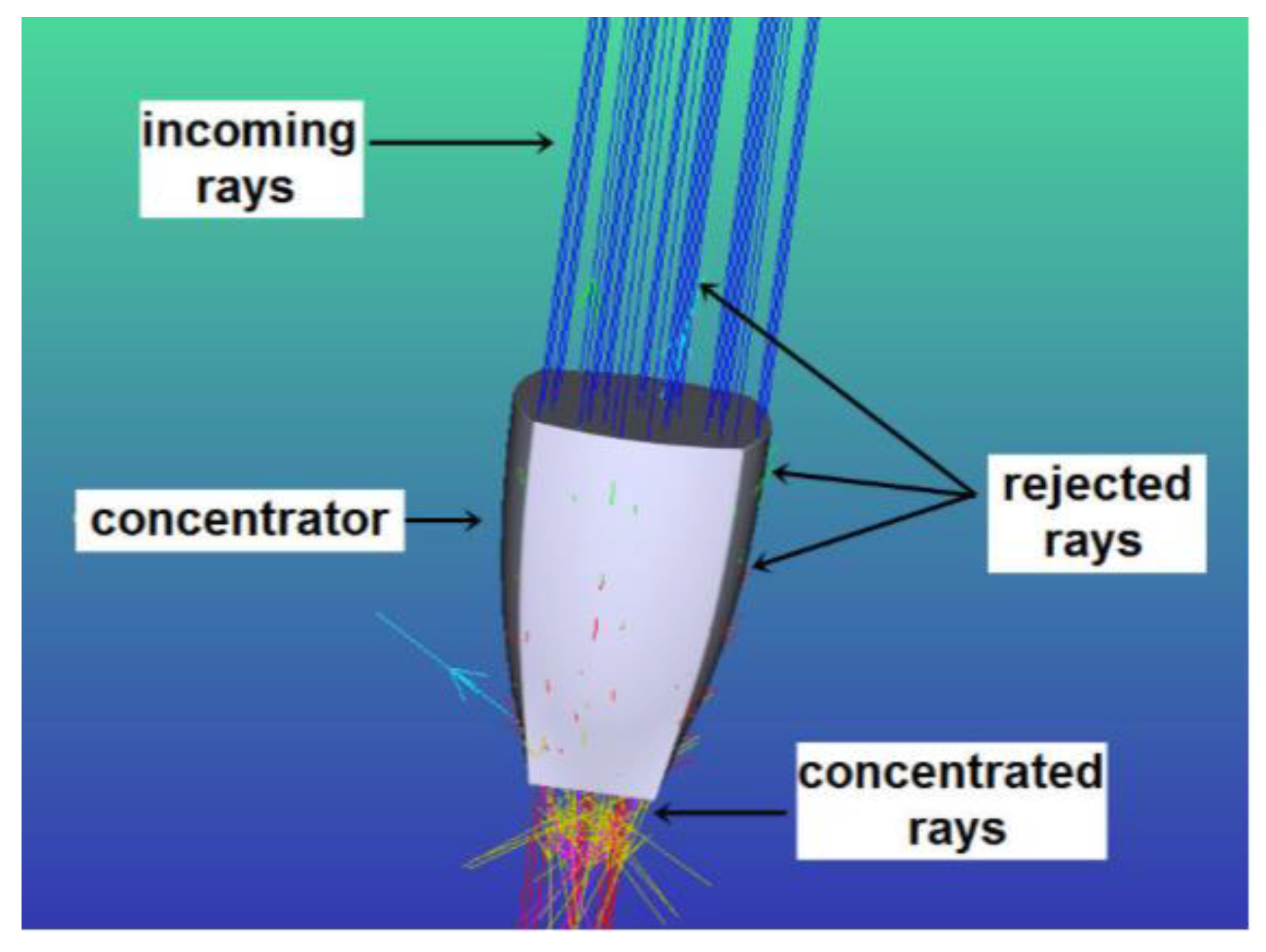
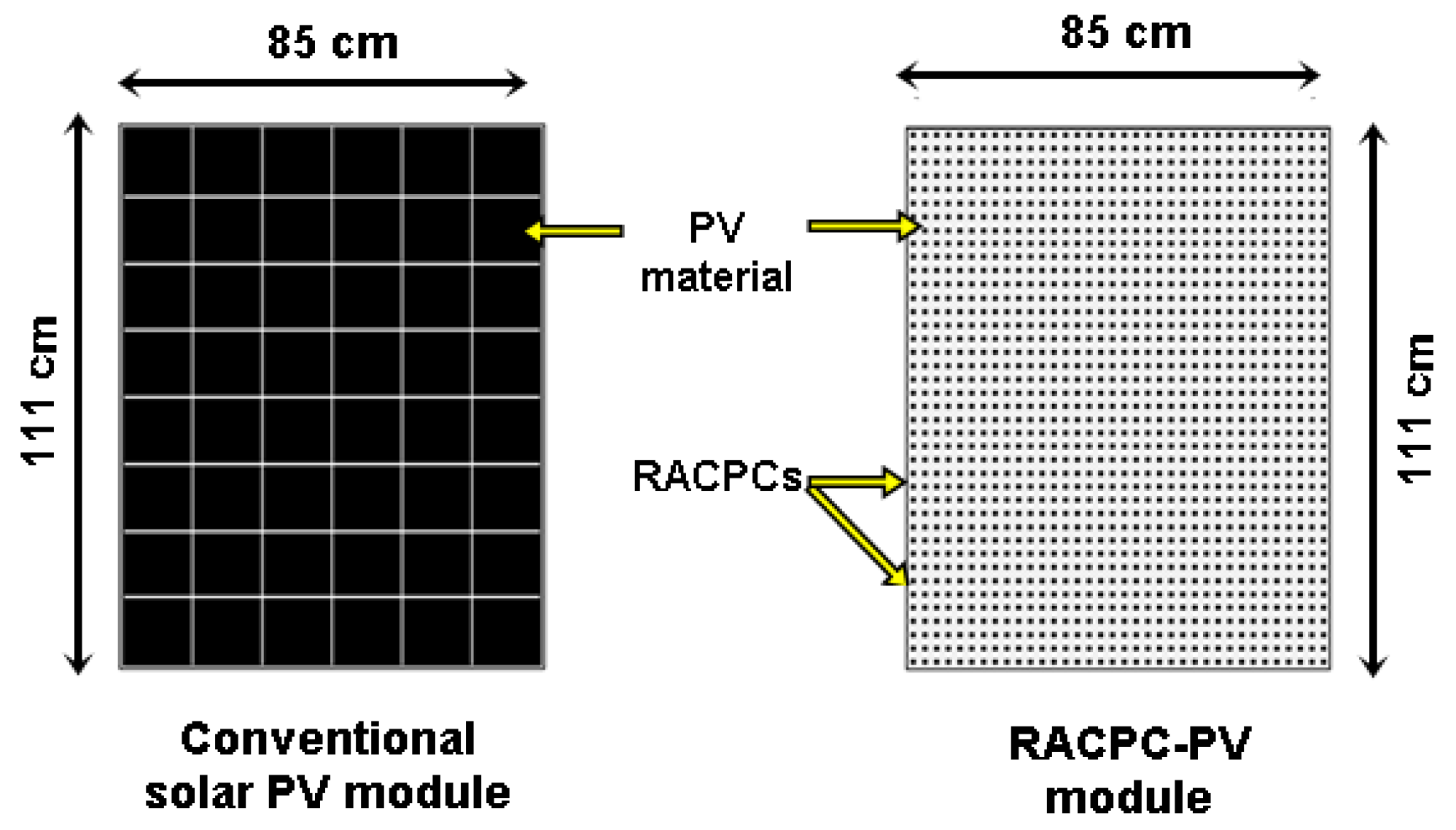
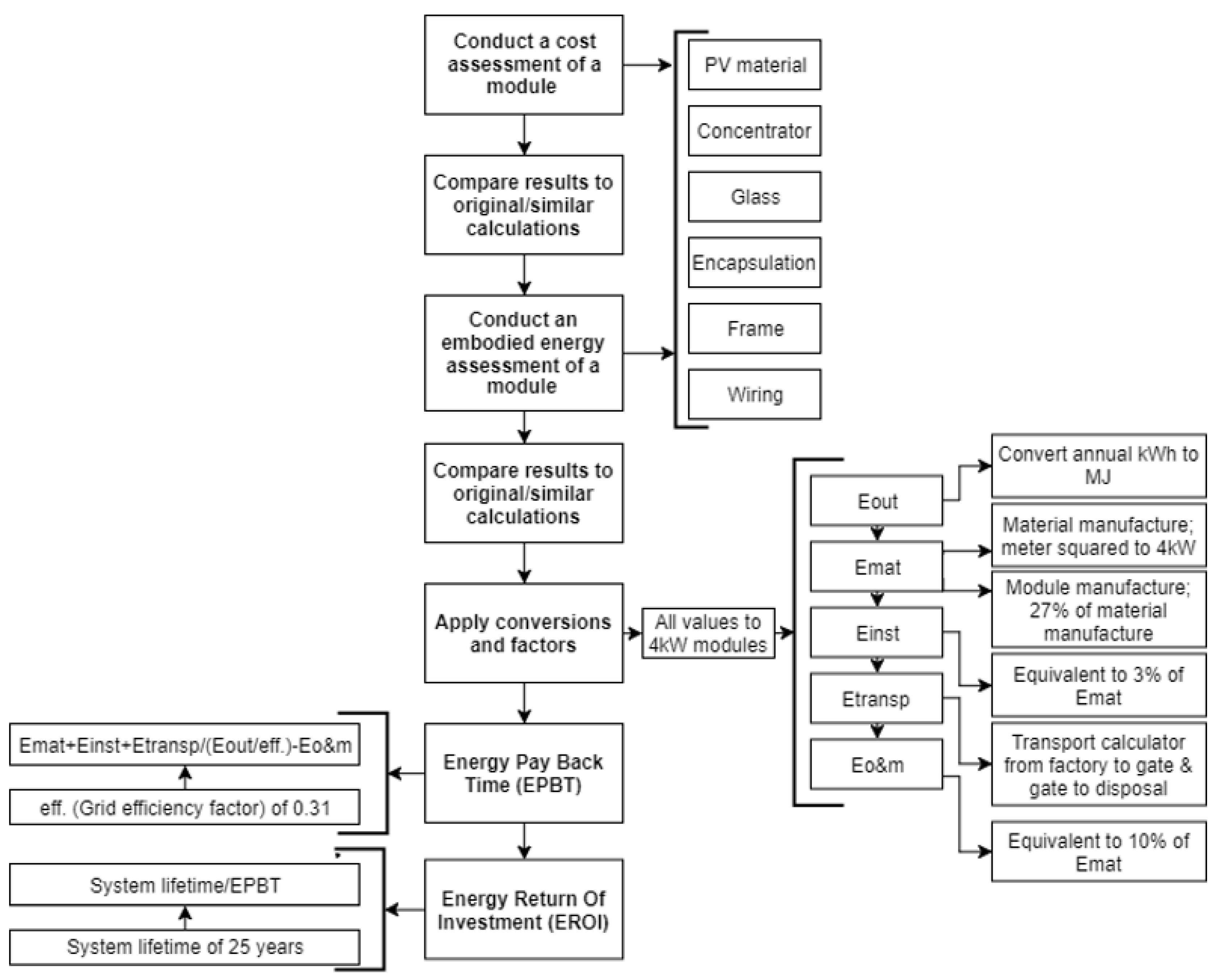



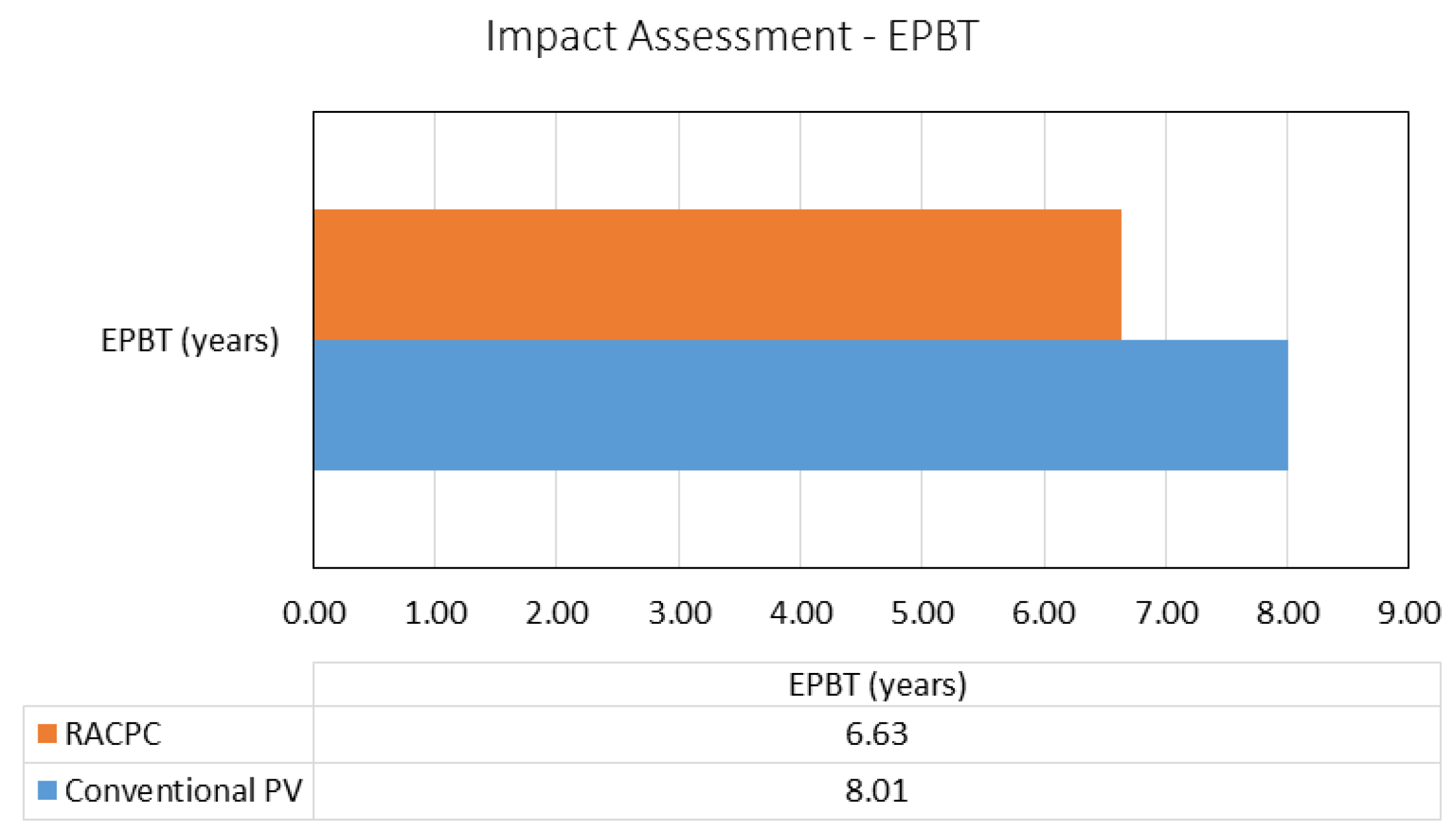
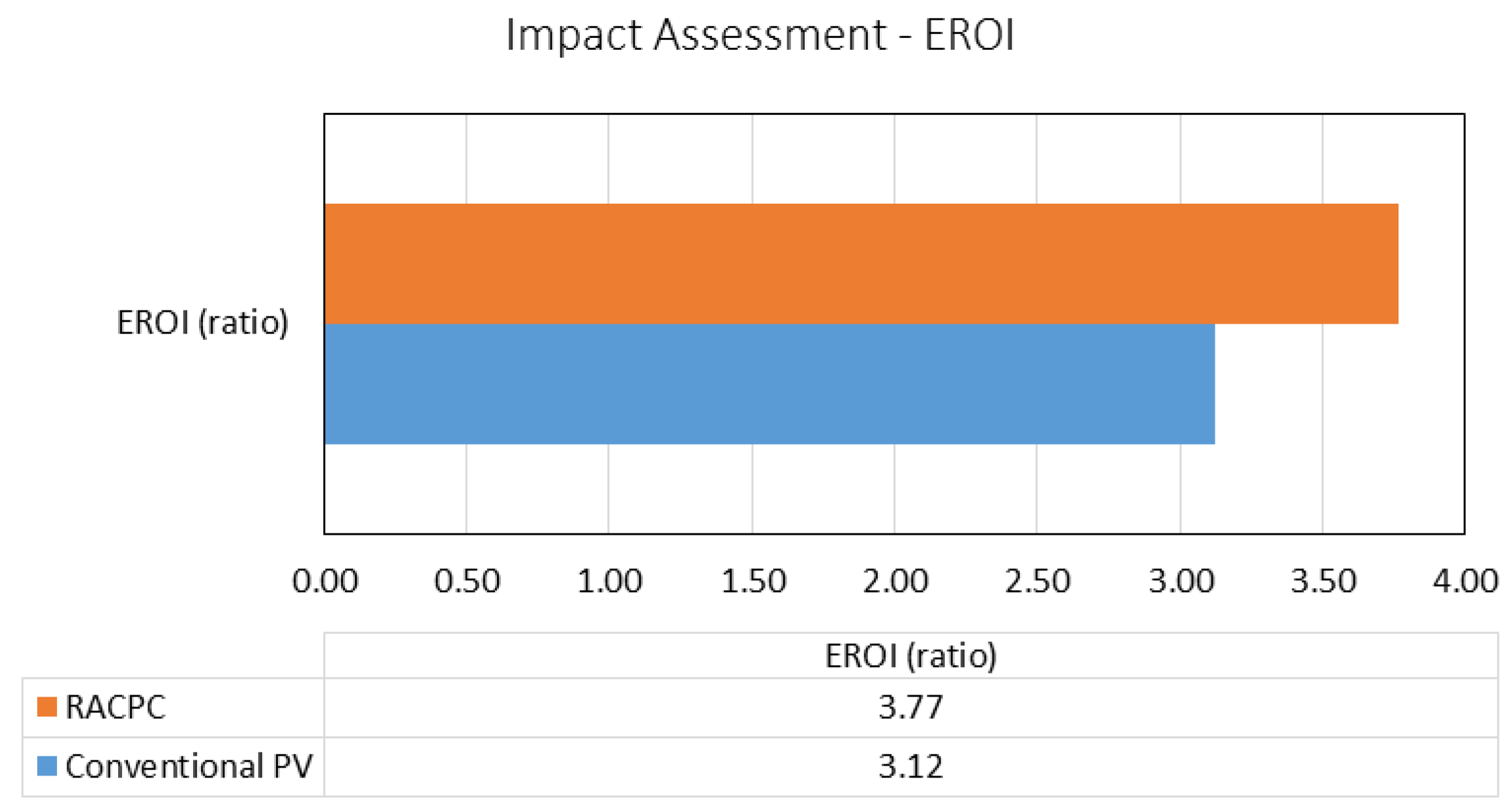
© 2020 by the authors. Licensee MDPI, Basel, Switzerland. This article is an open access article distributed under the terms and conditions of the Creative Commons Attribution (CC BY) license (http://creativecommons.org/licenses/by/4.0/).
Share and Cite
Zawadzki, P.; Muhammad-Sukki, F.; Abu-Bakar, S.H.; Bani, N.A.; Abubakar Mas’ud, A.; Ardila-Rey, J.A.; Munir, A.B. Life Cycle Assessment of a Rotationally Asymmetrical Compound Parabolic Concentrator (RACPC). Sustainability 2020, 12, 4750. https://doi.org/10.3390/su12114750
Zawadzki P, Muhammad-Sukki F, Abu-Bakar SH, Bani NA, Abubakar Mas’ud A, Ardila-Rey JA, Munir AB. Life Cycle Assessment of a Rotationally Asymmetrical Compound Parabolic Concentrator (RACPC). Sustainability. 2020; 12(11):4750. https://doi.org/10.3390/su12114750
Chicago/Turabian StyleZawadzki, Przemyslaw, Firdaus Muhammad-Sukki, Siti Hawa Abu-Bakar, Nurul Aini Bani, Abdullahi Abubakar Mas’ud, Jorge Alfredo Ardila-Rey, and Abu Bakar Munir. 2020. "Life Cycle Assessment of a Rotationally Asymmetrical Compound Parabolic Concentrator (RACPC)" Sustainability 12, no. 11: 4750. https://doi.org/10.3390/su12114750
APA StyleZawadzki, P., Muhammad-Sukki, F., Abu-Bakar, S. H., Bani, N. A., Abubakar Mas’ud, A., Ardila-Rey, J. A., & Munir, A. B. (2020). Life Cycle Assessment of a Rotationally Asymmetrical Compound Parabolic Concentrator (RACPC). Sustainability, 12(11), 4750. https://doi.org/10.3390/su12114750






